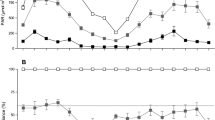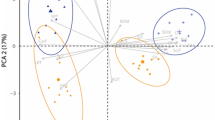Abstract
Light conditions on the floor of deciduous forests are determined by the leaf dynamics of canopy trees and gap formation. Such spatiotemporal variations of light availability should affect the resource partitioning strategies of understory herbs. Although rhizomatous species are common in understory, relationships between rhizome structure, vegetative growth, and sexual reproduction are unclear in terms of carbon allocation. We compared the photosynthetic characteristics and carbon translocation patterns in the under-canopy and light-gap sites between two summer-green perennial species: Cardamine leucantha with an annual long rhizome, and Smilacina japonica with a perennial short rhizome system. Flowering of both species occurs in early summer under decreasing light availability. In the light-gap, C. leucantha maintained high photosynthetic activity due to continuous leaf production, resulting in higher seed production than in the under-canopy. In contrast, the photosynthetic rate of S. japonica, producing leaves simultaneously, decreased with time irrespective of light conditions, resulting in stable seed production in both sites. Although seasonally decreasing light availability commonly restricts carbon assimilation of understory herbs, the responses of resource partitioning to variations in light availability depend greatly on the belowground structure of individual species.




Similar content being viewed by others
References
Araki K, Shimatani K, Ohara M (2007) Floral distribution, clonal structure, and their effects on pollination success in a self-incompatible Convallaria keiskei population in northern Japan. Plant Ecol 189:175–186
Beerling DJ, Bailey JP, Conolly AP (1994) Fallopia japonica (Houtt.) Ronse Decraene. J Ecol 82:959–979
Burd M (1994) Bateman principle and plant reproduction: the role of pollen limitation in fruit and seed set. Bot Rev 60:83–139
Gill RA, Jackson RB (2000) Global patterns of root turnover for terrestrial ecosystems. New Phytol 147:13–31
Hartnett DC, Bazzaz FA (1983) Physiological integration among intraclonal ramets in Solidago canadensis. Ecology 64:779–788
Hasegawa T, Kudo G (2005) Comparisons of growth schedule, reproductive property and allocation pattern among three rhizomatous Polygonatum species with reference to their habitat types. Plant Spec Biol 20:23–32
Huber H (1996) Plasticity of internodes and petioles in prostrate and erect Potentilla species. Funct Ecol 10:401–409
Hughes JW, Fahey TJ, Bormann FH (1988) Population persistence and reproductive ecology of a forest herb: Aster acuminatus. Am J Bot 75:1057–1064
Hutchings M (1999) Clonal plants as cooperative systems: benefits in heterogeneous environments. Plant Spec Biol 14:1–10
Ida TY, Kudo G (2008) Timing of canopy closure influences carbon translocation and seed production of an understorey herb, Trillium apetalon (Trilliaceae). Ann Bot 101:435–446
Janzen DH (1982) Cenizero tree (Leguminosae: Pithecellobium saman) delayed fruit development in Costa Rican deciduous forests. Am J Bot 69:1269–1276
Kamoi T, Kenzo T, Kuraji K, Momose K (2008) Abortion of reproductive organs as an adaptation to fluctuating daily carbohydrate production. Oecologia 154:663–677
Kanno H, Seiwa K (2004) Sexual versus vegetative reproduction in relation to forest dynamics in the understorey shrub, Hydrangea paniculata (Saxifragaceae). Plant Ecol 170:43–53
Kawano S (1985) Life-history chracteristics of temperate woodland plants in Japan. In: White J (ed) The population structure of vegetation. Junk, Dordrecht, pp 515–549
Kikuzawa K (2003) Phenological and morphological adaptations to the light environment in two woody and two herbaceous plant species. Funct Ecol 17:29–38
Klimeš S, Klimešova J, Hendriks R, van Groendael J (1997) Clonal plant architecture: a comparative analysis of form and function. In: Urbanska KM, de Kroon H, van Groendael J (eds) The ecology and evolution of clonal plants. Backhuys, Leiden, pp 1–30
Knight TM, Steets JA, Vamosi JC, Mazer SJ, Burd M, Campbell DR, Dudash MR, Johnston MO, Mitchell RJ, Ashman TL (2005) Pollen limitation of plant reproduction: pattern and process. Annu Rev Ecol Evol S 36:467–497
Kudo G, Ida TY, Tani T (2008) Linkages between phenology, pollination, photosynthesis, and reproduction in deciduous forest understory plants. Ecology 89:321–331
Lapointe L (1998) Fruit development in Trillium: dependence on stem carbohydrate reserves. Plant Physiol 117:183–188
Lovett-Doust L (1981) Population dynamics and local specialization in a clonal perennial (Ranunculus repens): 1 The dynamics of ramets in contrasting habitats. J Ecol 69:743–755
Mooney HA, Ehleringer JR (1997) Photosynthesis. In: Crawley MJ (ed) Plant ecology. Blackwell, Oxford, pp 1–27
Motten AF (1986) Pollination ecology of the spring wildflower community of a temperate deciduous forest. Ecol Monogr 56:21–42
Mulkey SS, Smith AP, Wright SJ (1991) Comparative life-history and physiology of 2 understory neotropical herbs. Oecologia 88:263–273
Naidu SL, DeLucia EH (1998) Physiological and morphological acclimation of shade grown tree seedlings to late season canopy gap formation. Plant Ecol 138:27–40
Niesenbaum RA (1993) Light or pollen: seasonal limitations on female reproductive success in the understory shrub Lindera benzoin. J Ecol 81:315–323
Oguchi R, Hikosaka K, Hiura T, Hirose T (2006) Leaf anatomy and light acclimation in woody seedlings after gap formation in a cool temperate deciduous forest. Oecologia 149:571–582
Price EAC, Gamble R, Williams GG, Marshall C (2001) Seasonal patterns of partitioning and remobilization of 14C in the invasive rhizomatous perennial Japanese knotweed (Fallopia japonica (Houtt.) Ronse Decraene). Evol Ecol 15:347–362
Rothstein DE, Zak DR (2001) Photosynthetic adaptation and acclimation to exploit seasonal periods of direct irradiance in three temperate, deciduous-forest herbs. Funct Ecol 15:722–731
Simard SW, Durall DM, Jones MD (1997) Carbon allocation and carbon transfer between Betula papyrifera and Pseudotsuga menziesii seedlings using a 13C pulse-labeling method. Plant Soil 191:41–55
Skillman JB, Strain BR, Osmond CB (1996) Contrasting patterns of photosynthetic acclimation and photoinhibition in two evergreen herbs from a winter deciduous forest. Oecologia 107:446–455
Stephenson AG (1981) Flower and fruit abortion: proximate causes and ultimate functions. Annu Rev Ecol S 12:253–279
Taylor RJ, Pearcy RW (1976) Seasonal patterns of the CO2 exchange characteristics of understory plants from a deciduous forest. Can J Bot 54:1094–1103
Turnbull MH, Doley D, Yates DJ (1993) The dynamics of photosynthetic acclimation to changes in light quantity and quality in 3 Australian rain forest tree species. Oecologia 94:218–228
Watkinson AR, Powell JC (1993) Seedling recruitment and the maintenance of clonal diversity in plant populations: a computer simulation of Ranunculus repens. J Ecol 81:707–717
Yamashita N, Ishida A, Kushima H, Tanaka N (2000) Acclimation to sudden increase in light favoring an invasive over native trees in subtropical islands, Japan. Oecologia 125:412–419
Acknowledgments
We are grateful to Yoshiaki Kameyama for his discussions on this study. We thank Atsuko Sugimoto and Yumi Hoshino for their assistance with stable isotope analysis, and Asuka Koyama, Tatsuya Saito and Tomohiro Shirasaki for their help with the field survey, and two anonymous reviewers for their critical comments on an earlier version of the manuscript. This work was partly supported by JSPS Research Fellowships of the Japan Society for the Promotion of Science for Young Scientists and Grants-in-Aid from the Japanese Society for the Promotion of Science for Scientific Research (nos. 16370007 and 1840501007).
Author information
Authors and Affiliations
Corresponding author
Rights and permissions
About this article
Cite this article
Ida, T.Y., Kudo, G. Comparison of light harvesting and resource allocation strategies between two rhizomatous herbaceous species inhabiting deciduous forests. J Plant Res 122, 171–181 (2009). https://doi.org/10.1007/s10265-008-0212-6
Received:
Accepted:
Published:
Issue Date:
DOI: https://doi.org/10.1007/s10265-008-0212-6




